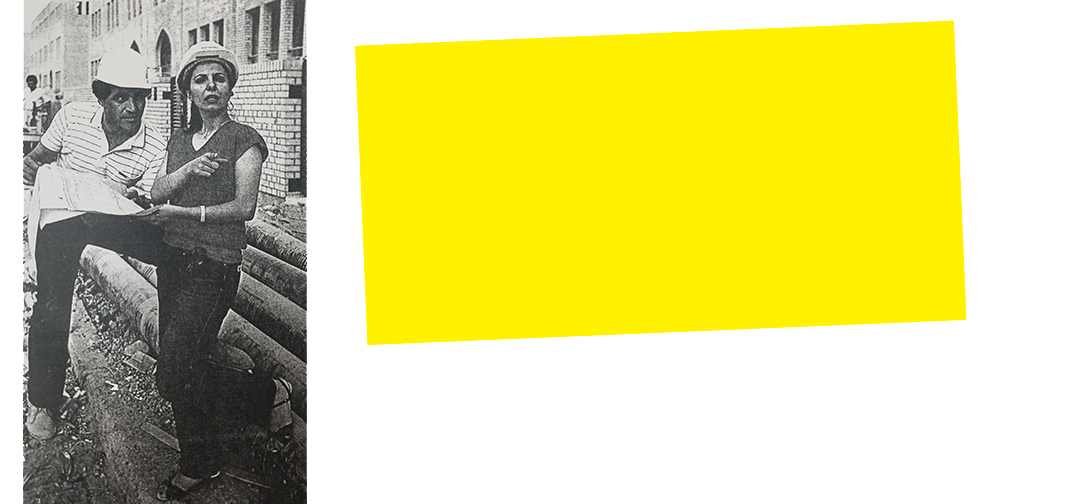

#CLIPPINGZ! this image is from my collection of analogue
printed images (I consider some of them "psychic" when pertinent imagery or text printed on the back create an unconscious message from the publishers. . .of course as we move entirely to screens, we loose these alignments on the back)
This image is taken from National Geographic, 1986. . .The caption identifies this as the newly constructed Ishtar Sheraton Hotel in Bagdad, where women are part of construction leadership. . .Amazing to think about Bagdad and the changing states of womenhood in the last two decades . . .
By Antonia Cundy
The creation of 400 miles of cycle paths and more than 60 plazas in New York has been lauded for breathing new life into a dense and heavily populated city.
But for Janette Sadik-Khan, the architect of those changes as transport commissioner for the city between 2007 and 2013, earning early recognition in a male-dominated profession was tough.
“I would come into the room and people would ask when the transportation commissioner was arriving, because I wasn’t a big hefty man wearing a construction hat,” Ms Sadik-Khan recalls. “The past has been very, very male.”
Ms Sadik-Khan is not alone in her experience. According to the World Bank, women occupy only 10 per cent of senior jobs at the world’s leading architecture firms. Urban planning is dominated by men and their legacy. Every city in the world was designed and built by men.
As a result, “cities work better for men than they do for women,” the World Bank says. So how would greater representation for women in urban planning change cities for the better?
“If you ask what a city designed by women would look like, the immediate reaction might be: ‘Oh yeah, you would have more ramps for buggies and more toilets’,” says Liane Hartley, founder of Urbanistas, a global network that promotes women in city design. “But I think we need to look bigger than that. It is about how we conceptualise cities in the first place.”
The consensus among women in the sector is that female-led urban planning could address some of the historical sexism built into cities, for example by making public spaces more hospitable to breast-feeding mothers, or providing more female loos.
But female-led design hopes to go further than this — creating cities that serve everyone, irrelevant of gender, age, disabilities, sexuality or ethnicity.
Fran Tonkiss, specialist in urban and economic sociology at the London School of Economics, says that because women know what it is like to be excluded by cities’ designs, they approach urban planning with this wholesale, more inclusive approach.
“It is about creating a physical environment that is not designed around the fully grown, able-bodied male subject.”
Ms Sadik-Khan points to the domination of cities by cars as an example of this male-centric approach. “In New York, male bike commuters outnumber women three to one,” she says. “If women [will not cycle because they] do not feel safe, there are probably a lot of things wrong with the street.” Reducing congestion, she says, is key to creating more inclusive cities.
In Barcelona, mayor Ada Colau is implementing “superblocks” throughout the city — groups of streets where cars are directed to perimeter roads and underground parking, allowing the inner streets to be turned over to pedestrian traffic and public spaces.
[We are a bit stuck with a certain type of city that was made for men to take trains to work and women to stay at home Saskia Sassen]
Anne Hidalgo, Paris mayor, has also vigorously implemented pedestrian and bike schemes, and is pushing the concept of the “15-minute city”, where residents’ homes, place of work, shopping, entertainment, education and healthcare necessities are all within a 15-minute walk or cycle.
The idea runs counter to the historical trend of separating business sectors from residential and school areas, which makes sharing care work more difficult, says Leslie Kern, author of Feminist City: Claiming Space in a Man-made World. “The feminist vision is not just where we make all of the care work that women do easier to do more of, but about how we can make cities that make that care work more easily distributable,” she says.
“We are a bit stuck with a certain type of city that was made for men to take trains to work and women to stay at home,” says Saskia Sassen, a sociologist and expert on urban theory. “It will take time, but little moves of a certain kind at some point scale up enough that change happens.”
There are also problems with the data that informs planning. In 2016, Miriam Gonzalez set up GeoChicas in Mexico, after she discovered the majority of entries added to open source maps (which feed maps used by Apple and Google) come from men — meaning services such as hospitals, toilets, childcare, sexual health clinics and domestic violence shelters are often overlooked.
Recommended Life & Arts Welcome to the 15-minute city The group, which consists of hundreds of contributors in more than 20 countries, encourages women to add mapping information and works on projects to improve how maps and urban planning cater to women.
“The problem is not just who is in the profession itself but whose voices are being listened to,” says Ms Kern.
“We have a small amount of women rising in certain positions where they did not used to be, but it is very little,” adds Ms Sassen.
But she remains optimistic that pressing questions around climate change and inequality will spark real change in the next generation. “It seems to me that these are times of change. Partly because of the environmental question, and partly because there are now more and more men who are closer in their way of thinking to how women think.”
